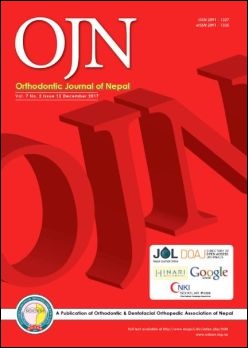Sella Turcica Bridging as a Predicator of Dentofacial Anomalies: A Cephalometric Analysis
DOI:
https://doi.org/10.3126/ojn.v7i2.20162Keywords:
bridging, dentofacial anomalies, sella turcicaAbstract
Introduction: Sellar changes are associated with several dentofacial anomalies. Clinicians should be aware of different morphological varaiants of sella turcica (ST).
Objective: To find the prevalence of sella turcica bridging and to analyze the absence or presence of bridging with a spectrum of dentofacial anomalies.
Materials & Method: 710 case records were selected from the database; out of which 473 subjects met the inclusion criteria. 280 lateral cephalogram revealed a normal shape of ST. Among them, 71 subjects were selected by interval sampling which were taken as the control group. Among initial 473 subjects, 78 samples showed ST bridging and were taken as the study group. Dental casts and radiographs (panoramic and cephalometric) were evaluated to find any dentofacial anomalies. Subjects were divided on the basis of dentofacial anomalies such as abnormal tooth position, size, shape, number, malocclusion, sagittal skeletal relationship. Chi-square test and binomial logistic regression analysis were done to find the association and correlation among the variables.
Result: In the study group, 32 subjects showed a complete bridging and 46 subjects a partial bridging of the sella turcica. There was no significant association between ST bridging and age, gender or ethnic groups. However, there was significant association (p=0.001) between the presence of bridging and dentofacial anomalies when compared with the control group.
Conclusion: The occurrence of ST bridging is 16.49% with no association to age, gender and ethnic groups in a Nepalese sample. Sella turcica bridging can be used as a diagnostic tool for early prediction of dentofacial anomalies
Downloads
Downloads
Published
How to Cite
Issue
Section
License
Copyright © held by Orthodontic & Dentofacial Orthopedic Association of Nepal
- Copyright on any research article is transferred in full to the Orthodontic & Dentofacial Orthopedic Association of Nepal upon publication in the journal. The copyright transfer includes the right to reproduce and distribute the article in any form of reproduction (printing, electronic media or any other form).
- Articles in the Orthodontic Journal of Nepal are Open Access articles published under the Creative Commons CC BY License (https://creativecommons.org/licenses/by/4.0/)
- This license permits use, distribution and reproduction in any medium, provided the original work is properly cited.




